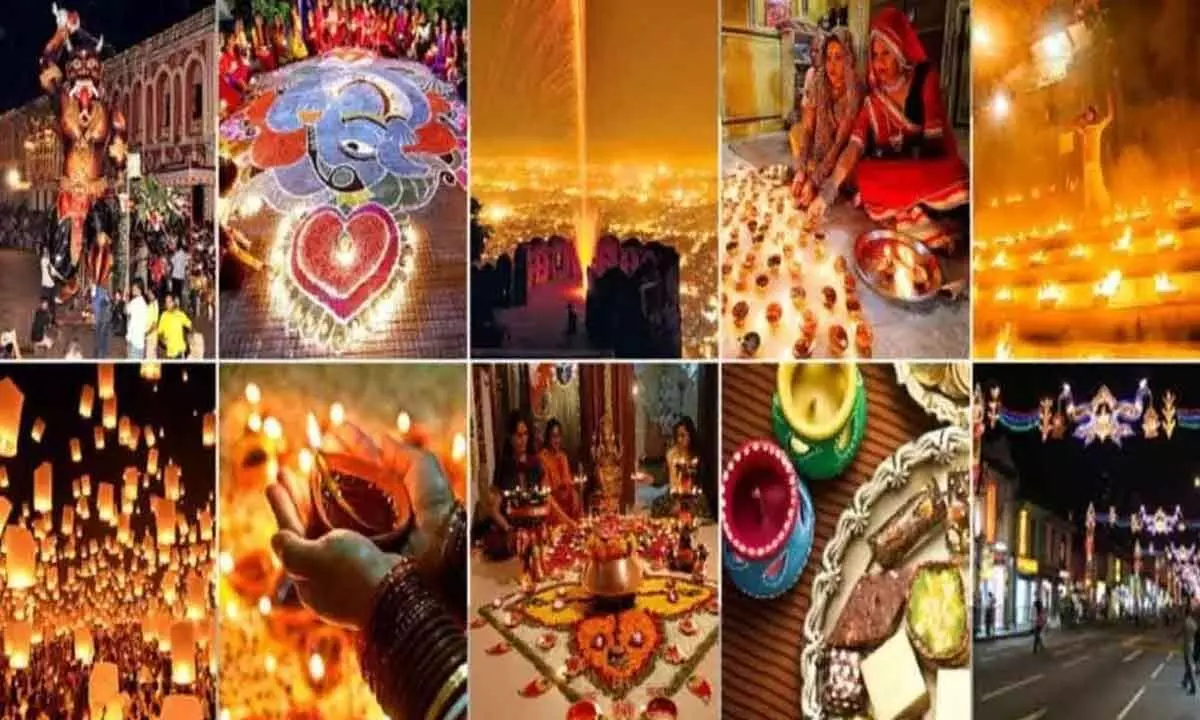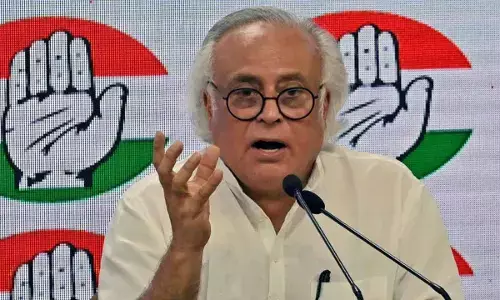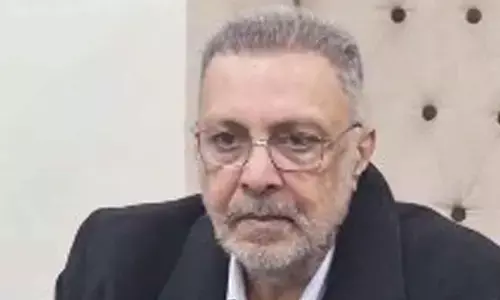The Dazzling Spell of Lights

Apart from festivals of lights, a natural marvel is the ‘aurora borealis’ or the northern lights, whose beautiful dancing waves of light have captivated people for millennia. It was Italian astronomer Galileo Galilei who originally coined the name “aurora borealis” in 1619 - after the Roman Goddess of Dawn, Aurora, and the Greek God of the north wind, Boreas. There are southern lights, too, with the dramatic process transforming into a cinematic atmospheric phenomenon that dazzles and fascinates, scientists and sky watchers alike
The country celebrated Diwali, the festival of lights, a few days ago. This piece is more about ‘lights’ as a subject then Diwali, as such.
Originally a Hindu festival, symbolising the spiritual victory of light over darkness, good over evil, and knowledge over ignorance, Diwali has over the centuries become a national festival that is also enjoyed by other religion, too. Diwali has increasingly attracted cultural exchanges, becoming an occasion for politicians and religious leaders worldwide to meet Hindu or Indian origin citizens, diplomatic staff or neighbours. The Catholic Dica stery Pontifical Council for Interreligious Dialogue, founded by Pope Paul VI, has begun to send official Diwali greetings, along with the Pope’s message, to Hindus.
Many governments encourage, or sponsor, Diwali-related festivities in their territories. While, the Government of Singapore organises cultural events every year, national and civic leaders, such as the former Prince Charles, have attended Diwali celebrations at in the UK, since 2009, Diwali has been also celebrated, at 10 Downing Street, the residence of the British Prime Minister, and at 1600, Pennsylvania Avenue, the White House, where the President of the United States of America resides, in 2009. On the eve of his first visit to India as President of the United States, Barack Obama released an official statement conveying his best wishes to those celebrating Diwali.
In another endearing custom, every year, during Diwali, Indian Armed Forces approach their Pakistani counterparts at the border bearing gifts of traditional Indian confectionery, a gesture that is returned in kind by the Pakistani soldiers, who give Pakistani sweets to the Indian soldiers.
Turning, now to the subject of ‘light’, it is interesting to note that a 1,000 oil lamps are lit at the Thousand Lights mosque situated in Anna Salai, Chennai. Prior to the construction of the mosque, in 1810, by the Nawab of Arcot, there was an Assembly Hall at the same site, to illuminate which the lamp had to be lit. It is one of the largest mosques India and a revered place of worship for Shia Muslims.
Interestingly, Zigong city, in Sichuan province of Southwest China, is also called the City of Thousand Lights. It is famous for its lanterns, which have been made for thousands of years, by artisans, on account of the belief that lanterns light people’s way to prosperity.
In 1962, I spent a few days at Shimla, staying with my uncle Krishnamurthy. Itching for adventure, my cousin Achut and I set off for a hike to Hattu peak. We took a bus to Narkanda village, some 60 km away, and camped there for the night, in a wayside ‘Dhaba’. The next morning, we set out for our expedition, armed primarily with enthusiasm, a total ignorance of the art of mountaineering, and no inkling, whatsoever, of what there was in store for us! And, having no guide, we landed on the wrong side of the mountain! There being no regular track to climb to the peak from that point and we had to depend, on stones and branches of plants, for foothold and leverage, to make our way up. Somehow or other, reach the top, bruised, bleeding, thirsty, and hungry. Needless to say, our stocks contained no food or water either!
But, more than handsome compensation, for our deprivation and suffering, was soon offered, by breathtakingly magnificent the Himalayan peaks. Meanwhile, we were greatly relieved to hear voices, from the other side of the mountain, where a unit of the Indian Army was located. The officers and the men were extraordinarily courteous. After first aid and food, they stocked us with all things necessary for the journey back and bade us a hearty farewell. To this day we cherish the wonderful view we enjoyed from the top, with memories of the suffering and pain fading away in comparison. Our feelings, were similar to those which the character, David Bowman, must have felt, in Arthur C Clarke’s futuristic novel ‘2010: Odyssey Two’. As the space craft ‘Discovery One’, enters the Star Gate, he sees stars rushing past his field of vision as though he is moving incredibly quickly. The Star Gate, however, never comes any closer, as time has virtually come to a halt on account of his velocity. As a matter of fact, Bowman had actually traveled through a ‘wormhole’ in space time.
The subject of light has also been a favourite with poets. We have, for instance, the hymn, by St John Henry Newman, in which the poet says:
“Lead, kindly light, amid the encircling gloom
Lead thou me on
The night is dark, and I am far from home
Lead thou me on”
As a Probationer, under training at the National Academy of Administration, at Mussoorie, I, used to watch with wonder, as Dehradun city, thousands of feet below, suddenly came alive with thousands of lights appearing with dazzling abruptness, as the city welcomed the arrival of night. And it was still daylight at Mussoorie!
Another natural marvel is the ‘aurora borealis’ or the northern lights, whose beautiful dancing waves of light have captivated people for millennia. It was Italian astronomer Galileo Galilei who originally coined the name “aurora borealis” in 1619 - after the Roman Goddess of Dawn, Aurora, and the Greek God of the north wind, Boreas. There are southern lights, too, with the dramatic process transforming into a cinematic atmospheric phenomenon that dazzles and fascinates, scientists and sky watchers alike.
References to light emitting and illuminating electrical appliances are often used to describe human qualities. A person who is slow on the uptake is, for example, often known as a ‘tube light’, on account of the propensity of that particular appliance to blink, several times, to begin with, before it gets fully switched on!
Lights, especially in the form of floodlights, have also provided the arena of games and sports. Football and cricket matches being played in floodlit stadia after day light hours is a common feature these days. The occasions present a totally different ambience, with a fairly large number of the spectators relaxing with their evening sundowners, day’s work having been put behind. Indoor games, such as badminton and squash. I have followed suit. I recall how the Lal Bahadur Shastri Stadium, in Hyderabad (originally known as the Fateh Maidan Stadium), was first fitted with floodlights, completely changing the status of the ground, as a coveted venue for hosting, national and international events.
The subject of festivals can hardly be discussed without a reference to the twin cities of Hyderabad and Secunderabad. The cities are endowed with a history replete with a cosmopolitan culture, Hindus, Muslims, Christians and Zoroastrians have lived there for centuries, in complete harmony with each other, and in a spirit of brotherhood. Enthusiastic and joyous celebration of all festivals irrespective of faiths is, therefore a natural consequence. Hindus join in Christmas and Ramzan festivities, while Christians celebrate Mahavir Jayanti, with Muslims being equally enthusiastic about Buddha Purnima.
That extraordinary facet, of the Hyderabadi culture, was highlighted by a few things I experienced in the last few days. During my customary walk, one morning, I met my senior colleague Daphne Rebello, when she mentioned about a commitment to join Diwali celebrations in a relative’s house. Upon returning home, I found a box of dry fruits waiting for me, a Diwali gift from my good friend, Ashok Kundalia, a Jain. and, just as I was unwrapping that very attractively packed parcel, I received Diwali greetings from my classmate in school Zia ul Hassan, a Muslim.
While all this is very heartwarming, one must remember the joke, about the twin cities, that the abundance of interfaith goodwill has resulted in there being practically no working days in a calendar year!
(The writer is formerly Chief Secretary, Government of Andhra Pradesh)










